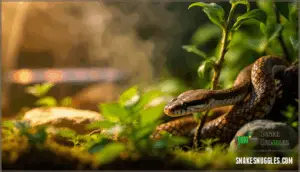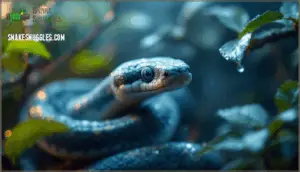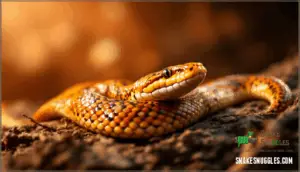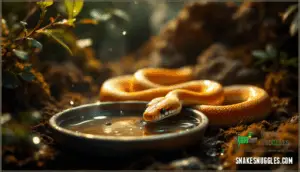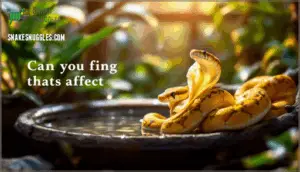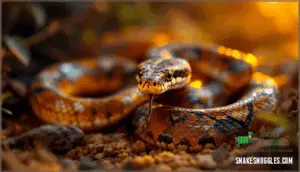This site is supported by our readers. We may earn a commission, at no cost to you, if you purchase through links.
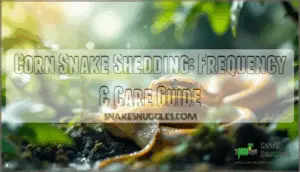
Understanding this natural cycle helps you recognize when your snake needs extra humidity, when cloudy eyes signal an upcoming shed, and how environmental factors like temperature and hydration influence the entire process.
Recognizing the signs early—from milky eyes to behavioral changes—lets you create ideal conditions that prevent stuck shed and support your snake’s health through each transformation.
Table Of Contents
- Key Takeaways
- How Often Do Corn Snakes Shed Their Skin?
- Signs Your Corn Snake is About to Shed
- Stages of The Shedding Process
- Factors Affecting Shedding Frequency
- Supporting Healthy Shedding in Corn Snakes
- Frequently Asked Questions (FAQs)
- Is it OK to hold my corn snake while its shedding?
- How long does it take for a corn snake to shed its skin?
- Why is my adult corn snake shedding so much?
- How often does a 2 year old corn snake shed?
- Can corn snakes eat their shed skin?
- How does a snakes age affect shedding color?
- Do different color morphs shed at different rates?
- Can shedding indicate health issues in corn snakes?
- How does breeding affect a corn snakes shedding cycle?
- Do corn snakes eat during the shedding process?
- Conclusion
Key Takeaways
- Juvenile corn snakes shed every 4–6 weeks during rapid growth, while adults slow to every 2–3 months once maturity stabilizes their body size and metabolic rate.
- Watch for four pre-shed warning signs—dull scales, cloudy eyes lasting 5–10 days, loose skin under the chin, and hiding or appetite loss—to adjust humidity to 65–75% before problems develop.
- Environmental factors directly control shedding success: humidity below 40% causes incomplete sheds in nearly one-third of cases, while temperatures between 70–85°F and proper hydration prevent stuck skin on tail tips and eye caps.
- A clean, one-piece shed signals your corn snake is thriving under optimal care—achieved through consistent humidity management, abrasive surfaces for skin removal, fresh water daily, and appropriate feeding schedules matched to age.
How Often Do Corn Snakes Shed Their Skin?
Corn snakes shed their skin throughout their lives, but how often depends largely on their age and growth stage. Young snakes shed much more frequently than adults because they’re growing rapidly, while mature snakes have a slower shedding schedule.
Understanding your snake’s shedding frequency helps you provide better care and spot any potential health issues early on.
Shedding Frequency in Juveniles Vs. Adults
Juvenile corn snakes shed dramatically more often than adults—usually every 4–6 weeks compared to adults’ 2–3 month cycles. This difference stems from their rapid growth patterns and accelerated metabolic rates during development. Young snakes nearly double in size within their first year, demanding frequent shedding cycles to accommodate expanding bodies. As they mature, growth slows markedly, so shedding frequency stabilizes. Understanding snake shedding process is vital for their care.
Key differences in shedding cycles:
- Juveniles experience 50–75% higher annual shedding events due to continuous tissue expansion
- Adults shed at regulated intervals reflecting slower growth and stabilized body mass
- Hatchlings may shed within 7–10 days post-hatching to initiate the ecdysis process
- Mature snakes may eventually shed only 3–4 times yearly as they age
Typical Shedding Timeline Throughout Life
Your corn snake’s shedding frequency shifts dramatically across life stages, creating a predictable timeline you can track. Hatchlings shed every 3–4 weeks during their first six months, driven by explosive growth of 2.5–4 cm monthly.
Juveniles slow to 4–6-week cycles as growth patterns stabilize.
Adults shed every 2–3 months—just 4–5 times yearly—while senior snakes (10+ years) extend to 3–4-month intervals as their aging process reduces metabolic demands and skin elasticity.
Seasonal and Environmental Influences
Beyond age-based patterns, environmental conditions dramatically reshape your corn snake’s shedding cycle. Temperature fluctuations between 26–29°C trigger sheds every 4–6 weeks, while cooler settings below 24°C extend intervals to 8–10 weeks. Humidity levels between 60–75% guarantee smooth shedding—dropping below 40% causes incomplete sheds in nearly a third of cases. Photoperiod effects matter too: 14-hour light cycles accelerate shedding by 25% compared to shorter exposure.
Geographic variations show southeastern snakes shed every 5–7 weeks due to consistent warmth and hydration, while northern populations stretch to 8–10 weeks during cooler months.
Maintaining proper UVB lighting needs is vital for the overall health and shedding cycle of corn snakes.
Signs Your Corn Snake is About to Shed
Your corn snake won’t just shed overnight—it’ll give you clear warning signs first. Watching for these signals helps you prepare the right conditions and avoid handling when your snake feels vulnerable.
Let’s walk through the four key indicators that shedding is coming.
Dull or Pale Scales
One of the earliest shedding cues you’ll notice is when your corn snake’s scales start to look dull or pale—like someone turned down the saturation dial on their normally vibrant coloration. This dulling happens because the old skin begins separating from the fresh layer underneath, creating a thin film that scatters light and masks the bright pigments in their scales.
During this pale phase, scale coloration can drop by 30–40%, and the contrast between their distinctive patterns fades noticeably. This skin regeneration process signals that the shedding process is actively underway, and your snake’s health depends on proper support during this time.
Cloudy or Milky Eyes
Shortly after scales lose vibrancy, you’ll see cloudy or milky eyes appear—your corn snake’s clearest shedding signal. This opacity develops when interstitial fluid builds between old and new spectacle layers (eye caps), temporarily impairing vision and causing defensive behavior.
The "in-blue" phase lasts 5–10 days before clearing, marking imminent spectacle detachment.
Maintaining 65–75% humidity prevents retained eye caps and aids healthy ocular shedding, protecting your snake’s long-term health.
Sagging Skin on Chin and Neck
As shedding nears, you’ll notice loose, sagging skin under your corn snake’s chin and neck—a pre-shed sign caused by fluid accumulating between old and new epidermal layers. This temporary laxity aids the shedding process by loosening the old skin from underlying tissues.
Maintaining proper humidity and offering abrasive surfaces facilitates smooth skin firming and prevents stuck shed, ensuring successful neck rejuvenation as your snake completes its natural anti-aging cycle and emerges with fresh collagen-rich scales.
Behavioral Changes (Hiding, Reduced Appetite)
As shedding approaches, your corn snake may hide up to 80% more often and refuse food—stress signals driven by impaired vision and shedding anxiety. Up to 90% of corn snakes experience appetite loss during the "blue phase," when milky eyes and heightened sensitivity make them feel vulnerable.
These behavioral changes reflect environmental stress and energy diversion toward skin regeneration. Maintaining proper humidity between 60–75% and avoiding handling reduces shedding-related reptile health issues, helping your snake navigate this natural cycle with minimal discomfort and supporting overall snake health.
Stages of The Shedding Process
Understanding the shedding process helps you know what to expect and when your corn snake needs extra support. The entire cycle usually unfolds over four to seven days, moving through three distinct phases.
Here’s what happens during each stage of your snake’s shed.
Pre-Shedding (Blue Phase)
Your corn snake’s eyes will cloud over like frosted glass during the blue phase, signaling shedding preparation is underway. This preshedding phase usually begins three to four days before the actual shed, with eye cloudiness lasting one to two days.
Fluid builds beneath the skin, creating that characteristic milky appearance as skin separation occurs.
You’ll want to maintain humidity between 60–70% during this stage—proper humidity control helps guarantee the corn snake completes its shed smoothly without complications.
Shedding Phase
The active sloughing begins when your snake rubs its snout against rough surfaces, loosening the skin around its head. This shedding phase usually lasts one to two days, with the skin peeling off in one continuous piece from head to tail if humidity control remains ideal.
You’ll notice your corn snake becomes more active during this brief window, working methodically to complete skin regeneration. Proper conditions during the shedding process prevent shedding complications that could compromise post-shed care.
Post-Shedding Recovery
Within 24 to 72 hours after the shedding process completes, you’ll observe your corn snake resuming normal activity and feeding behavior.
Post-shed care demands careful humidity management around 60–70% to support rehydration and skin regeneration, as moisture levels drop roughly 30% immediately after shedding.
Nutritional support becomes critical once appetite returns—offering prey after metabolic recovery prevents health issues and aids complete reptile care during this vulnerable window in corn snake care.
Factors Affecting Shedding Frequency
Shedding isn’t just about age—it’s shaped by a mix of factors you can actually control. Your corn snake’s health, environment, and stress levels all play a role in how often that old skin comes off.
Let’s break down what really matters regarding keeping your snake’s shedding cycle on track.
Age and Growth Rate
Your corn snake’s age and development stage directly drive how often it sheds. Hatchlings shed every 3–5 weeks as they grow rapidly—sometimes increasing body length by 7–8 times within their first two to three years.
As your snake matures and growth slows, shedding intervals stretch to every 2–3 months. Adult corn snakes at full size usually shed just 4–6 times annually, since they’re maintaining skin rather than accommodating major size increases.
Health and Nutrition
What you feed your snake shapes its shedding success. A balanced dietary intake rich in proteins and minerals keeps skin cells regenerating on schedule—snakes lacking vitamin A or E show 25% more incomplete sheds.
Feeding schedules aligned with growth (every 5–7 days for juveniles) and dietary variety prevent nutritional gaps, while vitamin supplements and proper hydration methods cut retained shed risk by 45%, supporting overall snake health issues prevention.
Humidity and Environmental Conditions
Beyond nutrition, your snake’s enclosure conditions directly control shedding frequency. Humidity levels between 60–75% provide the moisture layer needed for clean sheds—environments below 40% increase incomplete shedding by triggering dermal dehydration.
Temperature ranges of 70°F–85°F maintain metabolic efficiency, while environmental factors like substrate type and ventilation determine how well your reptile enclosure management facilitates natural shedding cycles.
Stress and Illness
Chronic stress disrupts your corn snake’s shedding process through neuroendocrine effects that suppress immune system function and trigger dysecdysis. When stress becomes constant, elevated corticosterone impairs protein synthesis and increases dysecdysis causes like incomplete skin separation—infected snakes may shed twice as often.
Environmental enrichment with climbing structures and hides reduces these stress behaviors, supporting snake health and wellness by preventing stuck shed and maintaining normal shedding cycles.
Supporting Healthy Shedding in Corn Snakes
Your corn snake’s successful shed depends on a few key environmental and care factors. Getting these right means your snake will slip out of its old skin smoothly, without complications or stress.
Let’s look at the practical steps you can take to support healthy shedding.
Maintaining Proper Humidity Levels
Humidity control makes all the difference when your corn snake is shedding. You’ll want to maintain levels between 50–60% in the enclosure, though boosting it to 65–70% during the blue phase helps soften the skin for easier detachment.
Use a digital hygrometer to monitor moisture management accurately, and consider adding a humid hide filled with sphagnum moss—it can reduce partial sheds by nearly 20%.
Proper snake hydration and a well-managed shedding environment guarantee the skin comes off in one clean piece.
Providing Abrasive Surfaces and Hides
Your corn snake needs rough textures to start the shedding process—branches, rocks, or cork bark let it rub off skin around the mouth and body. Snakes with multiple abrasive surfaces in their snake enclosure show a 32% drop in stuck shed problems, and when you combine these shedding aids with proper hide placement, you’ll see complete sheds over 85% of the time.
- Position abrasive materials near basking spots where humidity control aids skin elasticity
- Offer at least two hides (warm and cool zones) to reduce stress and encourage natural shed skin removal
- Use vertical surfaces like leaned driftwood for better contact angles during snake enrichment activities
Ensuring Adequate Hydration and Diet
You’ll notice water quality and dietary needs work hand-in-hand with humidity control—fresh water daily prevents bacterial buildup, while proper nutrition balance through appropriately sized prey aids hydration methods from the inside out.
Keeping humidity between 40–60% and feeding your snake weekly (juveniles) or biweekly (adults) creates the foundation for healthy shedding, since balanced diet and consistent hydration directly impact snake health and skin elasticity during the shedding process.
Addressing Stuck Shed and When to Seek Help
Sometimes stuck shed removal becomes necessary when patches of old skin refuse to release—this affects up to 20% of captive snakes under poor humidity management.
The shedding process stalls when hydration drops or temperatures fall outside the 70–85°F range, leading to shedding complications on tail tips and eye caps.
A 15-minute warm soak and gentle handling usually resolve minor stuck shed, but darkened skin signals ischemia requiring veterinary intervention.
Contact a reptile veterinarian if retained skin persists beyond one shedding cycle.
Frequently Asked Questions (FAQs)
Is it OK to hold my corn snake while its shedding?
Imagine this: your corn snake’s eyes cloud over like frosted glass, and you reach in to pick it up—only to trigger a defensive strike you’ve never seen before. It’s best to avoid handling your snake while shedding.
During this vulnerable period, handling risks increase due to impaired vision, heightened stress, and delicate skin that tears easily. Snake behavior shifts dramatically during the shedding process—your normally docile pet can’t see well through cloudy eyes, making it feel threatened by your approach. This spike in shedding stress elevates cortisol levels, compromising reptile health and wellness.
During shedding, impaired vision and heightened stress make your normally docile corn snake defensive and vulnerable to skin damage from handling
Injury prevention starts with humidity control (60-75%) and patience. Wait until your corn snake completes its shed before resuming normal snake handling routines—your pet snake ownership experience will be safer and less stressful for both of you.
How long does it take for a corn snake to shed its skin?
The shedding process usually takes about 7 to 14 days from start to finish. You’ll notice the blue phase—those cloudy, milky eyes—lasts around 4 to 7 days before clearing.
After the eyes clear, your snake sheds its skin within another 4 to 7 days, completing the molting process.
Why is my adult corn snake shedding so much?
Like a flag at half-mast signaling distress, frequent shedding in your adult corn snake often points to underlying trouble. Environmental stressors—such as improper humidity or temperature—are common shedding causes, along with medical conditions like infections or skin issues.
Dietary impact matters too; nutritional imbalances can disrupt the shedding process and increase shedding frequency in adult corn snakes, making factors influencing shedding worth investigating thoroughly.
How often does a 2 year old corn snake shed?
A 2-year-old corn snake generally sheds every 6–8 weeks as growth slows near adulthood. Shedding frequency depends on seasonal variation, humidity needs, and diet influence—factors that directly impact the shedding process and overall snake care and maintenance for your corn snake.
Can corn snakes eat their shed skin?
Here’s something unexpected: though snakes don’t need to eat their shed, some corn snakes do. While not common or well-documented, this behavior may stem from instinctual drives—nutrient recovery, environmental cleanliness, or camouflage tactics.
Individual variability plays a role, making it more habit than necessity in the reptile shedding process.
How does a snakes age affect shedding color?
Corn snakes undergo ontogenetic color change, with juveniles displaying more vibrant pigmentation that can fade in adults. During the shedding process, their skin appears dull, but post-shed coloration becomes brighter.
Morphs vary in color intensity due to genetic influences like the CLCN2 gene affecting their development.
Do different color morphs shed at different rates?
No scientific evidence shows that different color morphs affect shedding frequency or duration. Genetic traits influencing pigmentation don’t impact ecdysis regulation or shedding hormones.
Age, health, and environmental factors—not morph-specific care differences—determine the molting process timeline.
Can shedding indicate health issues in corn snakes?
Yes—abnormal shedding patterns often serve as health indicators for corn snakes. Dysecdysis, or incomplete shedding, usually signals underlying issues like improper humidity, dehydration, or nutrition impacts on skin health.
Frequent shedding issues may reveal parasites, infections, or metabolic problems affecting the snake’s health and wellbeing.
How does breeding affect a corn snakes shedding cycle?
Breeding triggers hormonal fluctuations that affect your corn snake’s shedding process. Males may shed more frequently during reproductive stress, while gravid females often experience delays or irregular shed cycles due to energy reallocation and environmental impact on their shedding frequency.
Do corn snakes eat during the shedding process?
Most corn snakes won’t eat during the shedding process. Appetite suppression kicks in during the pre-shed phase and can last several days to two weeks.
Vision impairment from cloudy eyes reduces their ability to detect prey, while metabolic shifts prioritize skin regeneration over digestion—minimizing digestive risks.
Conclusion
A snake that sheds its skin perfectly, in one unbroken piece, isn’t just lucky—it’s thriving under your care. Understanding how often corn snakes shed their skin, from the rapid cycles of youth to the measured pace of adulthood, gives you the power to anticipate their needs before problems arise.
Watch for cloudy eyes, offer higher humidity, and guarantee hydration stays consistent. When the shed peels away cleanly, it’s proof that temperature, moisture, and diet aligned exactly as they should. That translucent skin isn’t waste—it’s evidence of growth happening right.
- https://a-z-animals.com/blog/how-often-do-corn-snakes-shed-facts-about-their-skin/
- http://www.thecornsnake.co.uk/forum/topic.asp?TOPIC_ID=12296
- https://www.facebook.com/groups/2112792272280892/posts/4643484992544928/
- https://www.petoa.co.uk/reptiles/snakes/how-often-do-corn-snakes-shed/
- https://redinational.com/how-often-does-a-snake-shed-its-skin/

